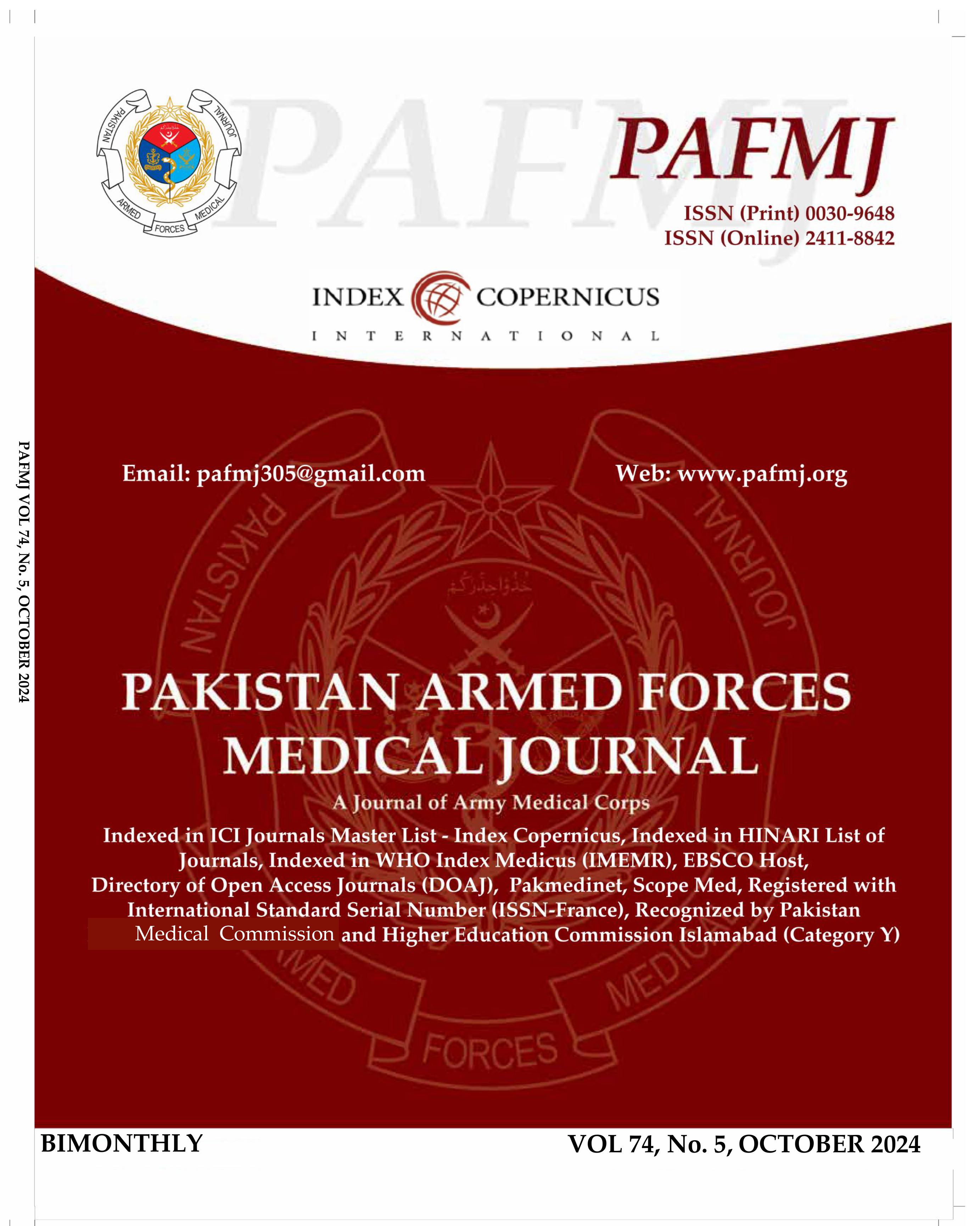Congenital Heart Disease among Neonates in a Neonatal Unit of a Tertiary Care Hospital
DOI:
https://doi.org/10.51253/pafmj.v74i5.7021Keywords:
Congenital Health Disease (CHD); Prevalence; Neonatal Intensive Care Unit (NICU); Outcome; Ventricular Septal Defect (VSD).Abstract
Objective: To determine the pattern of Congenital Heart Disease among neonates in a neonatal unit of a tertiary care hospital.
Study Design: Cross-sectional study.
Place and Duration of Study: The study was conducted at Neonatal Intensive Care Unit of Pak Emirates Military Hospital, Rawalpindi Pakistan, from Aug 2020 to Jan 2021.
Methodology: A total of 287 participants were enrolled in the study using non-probability consecutive sampling. Echocardiogram was used as a tool to diagnose congenital heart disease.
Results: Among 287 neonates, the mean weight was 2.36±0.73 kg with 49.5% being males and 50.5% females. Most of the neonates were delivered by Lower Segment Cesarean Section (227, 79.1%), while rest (60, 20.9%) were by spontaneous vaginal delivery. Neonates were mostly born at full term (159, 55.4%), followed by preterm (99, 34.5%), and early term (29, 10.1%). Only 34(11.8%) of the neonates showed any Congenital Heart Disease. Ventricular Septal Defect was the most common Congenital Heart Disease defect (15, 44.1%), followed by Patent Ductus Arteriosus (10, 29.4%) and Teratology of Fallot (4, 11.8%), while least common was Pulmonary Atresia (1, 2.9%). The relationship of Congenital Heart Disease with gender, mode of delivery, gestational age, and outcome of the neonate was found to be not significant.
Conclusion: A small proportion of the neonates had Congenital Heart Disease with no significant relationship with gender, delivery mode, gestational age, and outcome of the neonate.
Downloads
References
Alanen J, Korpimaki T, Kouru H, Sairanen M, Leskinen M, Gissler M, et al. First trimester combined screening biochemistry in detection of congenital heart defects. J Matern Fetal Neonatal Med 2019; 32(19): 3272-3277.
https://doi.org/10.1080/14767058.2018.1465526
Liu Y, Chen S, Zühlke L, Black GC, Choy MK, Li N, et al. Global birth prevalence of congenital heart defects 1970-2017: updated systematic review and meta-analysis of 260 studies. Int J Epidemiol 2019; 48(2): 455-463.
https://doi.org/10.1093/ije/dyz009
Teitel D. Recognition of undiagnosed neonatal heart disease. Clin Perinatol 2016; 43(1): 81-98.
https://doi.org/10.1016/j.clp.2015.11.004
Silberbach M, Hannon D. Presentation of congenital heart disease in the neonate and young infant. Pediatr Rev 2007; 28(4): 123-131.
https://doi.org/10.1542/pir.28-4-123
Ahmad R, Awan ZA, Bukshi F. A prevalence study of congenital heart disease in NWFP, Pakistan. Pak J Med Sci 2002; 18(2): 95-98.
Rizvi SF, Mustafa G, Kundi A, Khan MA. Prevalence of congenital heart disease in rural communities of Pakistan. J Ayub Med Coll Abbottabad 2015; 27(1): 124-127.
Jafree SR, Zakar R, Mustafa M, Fischer F. Mothers employed in paid work and their predictors for home delivery in Pakistan. BMC Pregnancy Childbirth 2018; 18(1): 316.
https://doi.org/10.1186/s12884-018-1961-4
Tikkanen J, Heinonen OP. Congenital heart disease in the offspring and maternal habits and home exposures during pregnancy. Teratology 1992; 46(5): 447-454.
https://doi.org/10.1002/tera.1420460509
Yun SW. Congenital heart disease in the newborn requiring early intervention. Korean J Pediatr 2011; 54(5): 183-191.
https://doi.org/10.3345/kjp.2011.54.5.183
Nayak K, Chandra GS, Shetty R, Narayan PK. Evaluation of fetal echocardiography as a routine antenatal screening tool for detection of congenital heart disease. Cardiovasc Diagn Ther 2016; 6(1): 44-49.
https://doi.org/10.3978/j.issn.2223-3652.2016.01.01
Zhang YF, Zeng XL, Zhao EF, Lu HW. Diagnostic value of fetal echocardiography for congenital heart disease: a systematic review and meta-analysis. Medicine 2015; 94(42): e1759.
https://doi.org/10.1097/MD.0000000000001759
Hussain S, Sabir MU, Afzal M, Asghar I. Incidence of congenital heart disease among neonates in a neonatal unit of a tertiary care hospital. J Pak Med Assoc 2014; 64(2): 175-178.
Bano S, Akhtar S, Khan U. Pediatric congenital heart diseases: patterns of presentation to the emergency department of a tertiary care hospital. Pak J Med Sci 2020; 36(3): 333-337.
https://doi.org/10.12669/pjms.36.3.1802
Prefumo F, Rossi AC. Mode of delivery in fetuses with congenital heart disease: a systematic review of the literature. Ultrasound Obstet Gynecol 2019; 54(S1): 288.
https://doi.org/10.1002/uog.20238
Liu Y, Chen S, Zühlke L, Black GC, Choy MK, Li N, et al. Global birth prevalence of congenital heart defects 1970-2017: updated systematic review and meta-analysis of 260 studies. Int J Epidemiol 2019; 48(2): 455-463.
https://doi.org/10.1093/ije/dyz009
Saxena A, Mehta A, Sharma M, Salhan S, Kalaivani M, Ramakrishnan S, et al. Birth prevalence of congenital heart disease: a cross-sectional observational study from North India. Ann Pediatr Cardiol 2016; 9(3): 205-209.
https://doi.org/10.4103/0974-2069.189119
Ali SR, Ahmed S, Lohana H. Disease patterns and outcomes of neonatal admissions at a secondary care hospital in Pakistan. Sultan Qaboos Univ Med J 2013; 13(3): 424-428.
Lawn JE, Cousens SN, Darmstadt GL, Bhutta ZA, Martines J, Paul V, et al; Lancet Neonatal Survival Series steering team. 1 year after The Lancet Neonatal Survival Series--was the call for action heard? Lancet 2006; 367(9521): 1541-1547.
Downloads
Published
Issue
Section
License
Copyright (c) 2024 Ammara Jamil, Farooq Ikram, Raazia Nawaz, Murtuza Hussain, Shagufta Naz, Saad Ateeq

This work is licensed under a Creative Commons Attribution-NonCommercial 4.0 International License.















